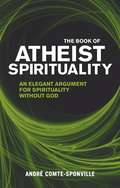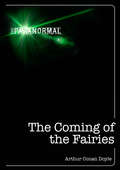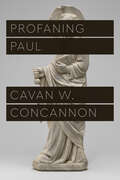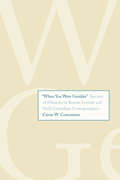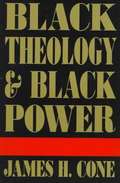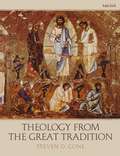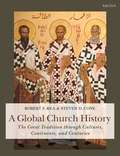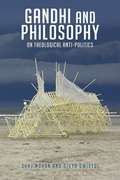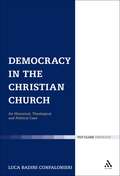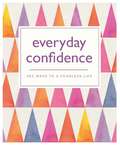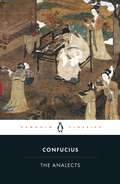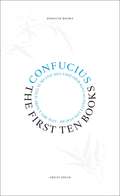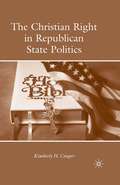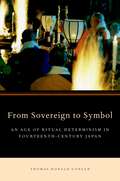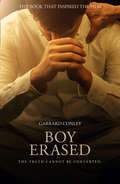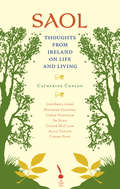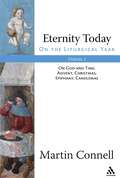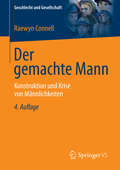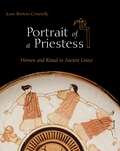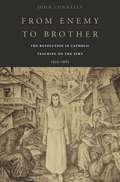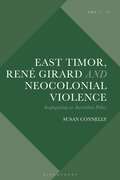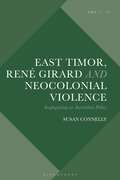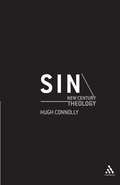- Table View
- List View
The Book of Atheist Spirituality
by Andre Comte-SponvilleCan we do without religion? Can we have ethics without God? Is there such thing as 'atheistic spirituality'? In this powerful book, the internationally bestselling author André Comte-Sponville presents a philosophical exploration of atheism - and reaches startling conclusions. Atheists, Comte-Sponville argues, are no less interested in a spiritual life than religious believers. But by allowing the concept of spirituality to become intertwined with religion and dogma, humanity has lost touch with the nature of a true spiritual existence. Using rigorous, reasoned arguments and clear, concise, and often humorous prose Comte-Sponville draws on both Eastern and Western philosophical traditions to propose the atheistic alternative to religion, based on the human need to connect to each other and to the universe. In doing so, he offers a convincing treatise on a new form of spiritual life.
The Coming of the Fairies (The Paranormal)
by Arthur Conan DoyleSir Arthur Conan Doyle (1859-1930), best known as the author of Sherlock Holmes stories but also a devout spiritualist, was entirely convinced by a set of photographs apparently showing two young girls from Cottingley in Yorkshire playing with a group of tiny, translucent fairies. To demonstrate his unshakeable belief in the spirit world, he published The Coming of the Fairies in 1922. Doyle’s book lays out the story of the photographs, their supposed provenance, and the implications of their existence.Featuring an original extract from a 1920 article from The Liverpool Echo about Doyle and the fairy photographs, this quirky and fascinating book allows us to get inside the mind of an intelligent, highly respected man who happened to believe in fairies.The Paranormal, the new ebook series from F&W Media International Ltd, resurrecting rare titles, classic publications and out-of-print texts, as well as new ebook titles on the supernatural-other-worldly books for the digital age. The series includes a range of paranormal subjects from angels, fairies and UFOs to near-death experiences, vampires, ghosts and witchcraft.
Profaning Paul (Class 200: New Studies in Religion)
by Cavan W. ConcannonA critical reconsideration of the repeated use of the biblical letters of Paul. The letters of Paul have been used to support and condone a host of evils over the span of more than two millennia: racism, slavery, imperialism, misogyny, and anti-Semitism, to name a few. Despite, or in some cases because of, this history, readers of Paul have felt compelled to reappropriate his letters to fit liberal or radical politics, seeking to set right the evils done in Paul’s name. Starting with the language of excrement, refuse, and waste in Paul’s letters, Profaning Paul looks at how Paul’s “shit” is recycled and reconfigured. It asks why readers, from liberal Christians to academic biblical scholars to political theorists and philosophers, feel compelled to make Paul into a hero, mining his words for wisdom. Following the lead of feminist, queer, and minoritized scholarship, Profaning Paul asks what would happen if we stopped recycling Paul’s writings. By profaning the status of his letters as sacred texts, we might open up new avenues for imagining political figurations to meet our current and coming political, economic, and ecological challenges.
"When You Were Gentiles": Specters of Ethnicity in Roman Corinth and Paul's Corinthian Correspondence (Synkrisis)
by Prof. Cavan W. ConcannonCavan W. Concannon makes a significant contribution to Pauline studies by imagining the responses of the Corinthians to Paul’s letters. Based on surviving written materials and archaeological research, this book offers a textured portrait of the ancient Corinthians with whom Paul conversed, argued, debated, and partnered, focusing on issues of ethnicity, civic identity, politics, and empire. In doing so, the author provides readers a unique opportunity to assess anew, and imagine possibilities beyond, Paul’s complicated legacy in shaping Western notions of race, ethnicity, and religion.
Black Theology And Black Power (PDF)
by James H. ConeFirst published in 1969, "Black Theology & Black Power" provided the first systematic presentation of black theology. Relating the militant struggle for liberation with the gospel message of salvation, James Cone laid the foundation for an original interpretation of Christianity that retains its urgency and challenge today.
Theology from the Great Tradition
by Steven D. ConeThis textbook provides complete and comprehensive coverage of the theological tradition of Aquinas, Maximus, Luther, Irenaeus, Lonergan, von Balthasar, Schmemann, Meyendorf and Barth. Each section of this textbook explores a wide variety of questions – who are we? Is there a God, and if so, what is his nature? Who is Jesus? What does it mean that we live both in sin and righteousness? It consists of 15 modules that are comprised of 46 chapters. Each module has two parts: there are systematic chapters that discuss and explain each module's topic; and the final chapter of each module examines 4 to 6 primary sources that are important for each topic.This textbook includes an extensive range of pedagogical features: - Sample tests in which each objective question has been quality tested by classroom use (with a discrimination index) - A discussion guide for each chapter - Learning objectives linked to each chapter - The text includes bold-faced terms, boxed text sections that identify central figures and points of debate, study question, chapter summaries, glossary
Theology from the Great Tradition
by Steven D. ConeThis textbook provides complete and comprehensive coverage of the theological tradition of Aquinas, Maximus, Luther, Irenaeus, Lonergan, von Balthasar, Schmemann, Meyendorf and Barth. Each section of this textbook explores a wide variety of questions – who are we? Is there a God, and if so, what is his nature? Who is Jesus? What does it mean that we live both in sin and righteousness? It consists of 15 modules that are comprised of 46 chapters. Each module has two parts: there are systematic chapters that discuss and explain each module's topic; and the final chapter of each module examines 4 to 6 primary sources that are important for each topic.This textbook includes an extensive range of pedagogical features: - Sample tests in which each objective question has been quality tested by classroom use (with a discrimination index) - A discussion guide for each chapter - Learning objectives linked to each chapter - The text includes bold-faced terms, boxed text sections that identify central figures and points of debate, study question, chapter summaries, glossary
A Global Church History: The Great Tradition through Cultures, Continents and Centuries
by Steven D. Cone Robert F. ReaHow did the Christian Church originate, what journeys has it taken over two millennia, and how did it come to exist in its present, myriad forms? The answers to these questions form a tapestry of history that reaches from first century Palestine to the ends of the earth. This volume tells this rich story from an ecumenical perspective, drawing on both Eastern and Western historic sources in exploring the rise of Eastern Orthodoxy; the church across Asia, Africa, and the Americas; and the reformations of the Western Church; including the diversity of contemporary voices.The work benefits from many pedagogical features:- boxed text sections identifying central figures and points of debate- study questions for each chapter- chapter summaries- maps--charts--indexSupplemented by over 400 illustrations, this book embraces the universality of historic and current Christianity, creating a single and comprehensive volume for students of Church history and systematic theology.
A Global Church History: The Great Tradition through Cultures, Continents and Centuries
by Steven D. Cone Robert F. ReaHow did the Christian Church originate, what journeys has it taken over two millennia, and how did it come to exist in its present, myriad forms? The answers to these questions form a tapestry of history that reaches from first century Palestine to the ends of the earth. This volume tells this rich story from an ecumenical perspective, drawing on both Eastern and Western historic sources in exploring the rise of Eastern Orthodoxy; the church across Asia, Africa, and the Americas; and the reformations of the Western Church; including the diversity of contemporary voices.The work benefits from many pedagogical features:- boxed text sections identifying central figures and points of debate- study questions for each chapter- chapter summaries- maps--charts--indexSupplemented by over 400 illustrations, this book embraces the universality of historic and current Christianity, creating a single and comprehensive volume for students of Church history and systematic theology.
Democracy in the Christian Church: An Historical, Theological and Political Case (Ecclesiological Investigations)
by Luca Badini ConfalonieriAre church structures divinely-willed, and consequently both permanent and irreversible? Can Christians modify the polity of their church like they do with that of civil society? What would be the role of the office of oversight in a Christian church democratically organized? What would its relationship with specialized authorities within the community be? Building on a remarkable number of specialist studies in exegesis, church history, political philosophy, canon law, and ecclesiology, this book convincingly fulfils three goals. First, it encourages Christians to determine the political outlook of their faith community. Secondly, it provides some fundamental criteria for judging the ethical value of church structures, on the basis of Bernard Lonergan's cognitional theory and with the help of recent insights from contemporary political philosophy. Thirdly, it outlines a largely novel and groundbreaking understanding of a democratic church. In the process, it engages with some of the most difficult ecclesiological issues faced by most Christian churches.
Everyday Confidence: 365 ways to a fearless life (365 Ways to Everyday...)
by Everyday ConfidenceFilled with positive affirmations from a host of inspiring people, as well as easy-to-action suggestions for building up your sense of self-worth, Everyday Confidence will inspire and encourage you to stand up for yourself. With daily tips and brave actions for boosting your courage, this book helps you to take small, significant steps to an assertive and truly confident you.About the Everyday seriesGet to grips with a single subject in small, manageable steps with the Everyday series. From inspirational quotes to professional tips, the short daily entries fit perfectly into the hustle and bustle of everyday life. These small, chunky books are a perfect gift as well as a great self-purchase.
The Analects: Or The Conversations Of Confucius With His Disciples And Certain Others, (Ideas For Life Ser.)
by Confucius D. C. LauThe Analects express a philosophy, or a moral code, by which Confucius, one of the most humane thinkers of all time, believed everyone should live. Upholding the ideals of wisdom, self-knowledge, courage and love of one's fellow man, he argued that the pursuit of virtue should be every individual's supreme goal. And, while following the Way, or the truth, might not result in immediate or material gain, Confucius showed that it could nevertheless bring its own powerful and lasting spiritual rewards.
The First Ten Books
by Confucius D. C. LauThroughout history, some books have changed the world. They have transformed the way we see ourselves - and each other. They have inspired debate, dissent, war and revolution. They have enlightened, outraged, provoked and comforted. They have enriched lives - and destroyed them. Now Penguin brings you the works of the great thinkers, pioneers, radicals and visionaries whose ideas shook civilization and helped make us who we are.Perhaps the most widely read thinker of all time, Confucius transformed Chinese philosophy with his belief that the greatest goal in life was pursuit of 'The Way': a search for virtue not as a means to rewards in this world or the next, but as the pinnacle of human existence.
The Christian Right in Republican State Politics
by K. CongerThis book examines the influence and activities of the Christian Right at the state level. One of the first attempts at studying the Christian Right comparatively across states, this book offers a new theoretically-driven perspective on how political context and constraints shape the Christian Right s strategy and influence. Based on evidence from in-depth case studies of three states - Indiana, Missouri, and Arizona - and qualitative and quantitative data from a wide variety of other states, its conclusions demonstrate that the movement s strategies and behavior are based on the political opportunity structure of each state, the movement s internal resources, and its ability to utilize threat-based mobilization.
From Sovereign to Symbol: An Age of Ritual Determinism in Fourteenth Century Japan
by Thomas Donald ConlanFourteenth-century Japan witnessed a conflict about the nature of power that was expressed through the rituals and institutions of two rival courts. Ultimately, political authority came to be asserted through the language of esoteric Buddhist rituals, which determined the parameters of political possibility in Japan.
Boy Erased: A Memoir
by Garrard ConleyNOW A MAJOR MOTION PICTURE STARRING LUCAS HEDGES, RUSSELL CROWE AND NICOLE KIDMAN, AND WRITTEN AND DIRECTED BY JOEL EDGERTON ‘A necessary, beautiful book’ Garth Greenwell, author of What Belongs to You ‘A brilliant memoir’ Guardian
Saol: Thoughts from Ireland on Life & Living
by Catherine ConlonFrom the earliest times people have pondered why we are here; philosophers and scientists continue to grapple with the question. For this compilation of wisdom and insights into what is truly important, Catherine Conlon tracked down people from varying walks of life, all with a deep connection to Ireland, for answers to life’s crucial questions. Contributors include Maureen Gaffney, Chris Hadfield, Sr Stan, Colum McCann, Alice Taylor, Conor Pope and many others from the worlds of writing, politics, journalism, charity and more. This collection will inspire self-reflection and lead us to reconsider our notion of the real value of our lives.
Eternity Today, Vol. 1: On the Liturgical Year: On God and Time, Advent, Christmas, Epiphany, Candlemas
by Martin ConnellAccording to Dom Gregory Dix, the basic shape of the Christian liturgy has remained the same "ever since thirteen men met for supper in an upper room at Jerusalem" some two thousand years ago. According to Martin Connell, the same cannot be said for the liturgical year. The Triduum, or three days of Easter, only emerged in the fourth century. So, too, did Christmas. Earlier, Epiphany was the birthday of the Savior. Although a pre-Easter fast of variable length was observed since earliest times, the precise Forty Day span only appeared, once again, in the fourth century. And that foundational fourth century also saw the beginnings of the observance of Advent, which actually took centuries to catch on. As Connell demonstrates in this fascinating book, the varieties of Christian observance emerged in local communities stretching from Gaul to India and were often born in the struggles that were define orthodoxy and heresy.Eternity Today is a vade mecum for anyone who wishes to observe the liturgical year with intelligent devotion. Throughout, Connell aims to recover the theology and spirituality of the Christian year. As an aid to reflection, he incorporates numerous selections of contemporary poetry, thereby demonstrating how secular poets can often hit upon a point that finds its echo in Christian life and ritual.Eternity Today: The Liturgical Year, Volume 1 covers Advent, Christmas, Epiphany, Candlemas, and Ordinary Time.
Der gemachte Mann: Konstruktion und Krise von Männlichkeiten (Geschlecht und Gesellschaft #8)
by Raewyn ConnellMännlichkeit, so zeigt dieses überaus erfolgreiche Buch, ist eine gesellschaftlich konstruierte Kategorie, die längst nicht mehr eindeutig ist. Wie das soziale Geschlecht ,männlich‘ entstanden ist, und wie einzelne Männer mit der Vielfalt und den Krisen moderner Männlichkeiten umgehen, wird anschaulich geschildert. In zwei neuen Kapiteln beleuchtet die Autorin die bisherige Rezeption ihrer Arbeit zur „hegemonialen Männlichkeit“ und stellt Geschlechterverhältnisse in den Kontext einer Weltgesellschaft mit neoliberaler Prägung.
Portrait of a Priestess: Women and Ritual in Ancient Greece
by Joan Breton ConnellyIn this sumptuously illustrated book, Joan Breton Connelly gives us the first comprehensive cultural history of priestesses in the ancient Greek world. Connelly presents the fullest and most vivid picture yet of how priestesses lived and worked, from the most famous and sacred of them--the Delphic Oracle and the priestess of Athena Polias--to basket bearers and handmaidens. Along the way, she challenges long-held beliefs to show that priestesses played far more significant public roles in ancient Greece than previously acknowledged.Connelly builds this history through a pioneering examination of archaeological evidence in the broader context of literary sources, inscriptions, sculpture, and vase painting. Ranging from southern Italy to Asia Minor, and from the late Bronze Age to the fifth century A.D., she brings the priestesses to life--their social origins, how they progressed through many sacred roles on the path to priesthood, and even how they dressed. She sheds light on the rituals they performed, the political power they wielded, their systems of patronage and compensation, and how they were honored, including in death. Connelly shows that understanding the complexity of priestesses' lives requires us to look past the simple lines we draw today between public and private, sacred and secular.The remarkable picture that emerges reveals that women in religious office were not as secluded and marginalized as we have thought--that religious office was one arena in ancient Greece where women enjoyed privileges and authority comparable to that of men. Connelly concludes by examining women's roles in early Christianity, taking on the larger issue of the exclusion of women from the Christian priesthood. This paperback edition includes additional maps and a glossary for student use.
From Enemy to Brother: The Revolution In Catholic Teaching On The Jews, 1933-1965
by John ConnellyIn 1965 the Second Vatican Council declared that God loves the Jews. Yet the Church had taught for centuries that Jews were cursed by God, and had mostly kept silent as Jews were slaughtered by Nazis. How did an institution whose wisdom is said to be unchanging undertake one of the largest, yet most undiscussed, ideological swings in modern history?
From Enemy to Brother: The Revolution In Catholic Teaching On The Jews, 1933-1965
by John ConnellyIn 1965 the Second Vatican Council declared that God loves the Jews. Yet the Church had taught for centuries that Jews were cursed by God, and had mostly kept silent as Jews were slaughtered by Nazis. How did an institution whose wisdom is said to be unchanging undertake one of the largest, yet most undiscussed, ideological swings in modern history?
East Timor, René Girard and Neocolonial Violence: Scapegoating as Australian Policy (Violence, Desire, and the Sacred)
by Susan ConnellyIn a new historical interpretation of the relationship between Australia and East Timor, Susan Connelly draws on the mimetic theory of René Girard to show how the East Timorese people were scapegoated by Australian foreign policy during the 20th century.Charting key developments in East Timor's history and applying three aspects of Girard's framework – the scapegoat, texts of persecution and conversion – Connelly reveals Australia's mimetic dependence on Indonesia and other nations for security. She argues that Australia's complicity in the Indonesian invasion and occupation of East Timor perpetuated the sacrifice of the Timorese people as victims, thus calling into question the traditional Australian values of egalitarianism and fairness. Connelly also examines the embryonic conversion process apparent in levels of recognition of the innocent victim and of the Australian role in East Timor's suffering, as well as the consequent effects on Australian self-perception.Emphasising Girardian considerations of fear, suffering, forgiveness and conversion, this book offers a fresh perspective on Australian and Timorese relations that in turn sheds light on the origins and operations of human violence.
East Timor, René Girard and Neocolonial Violence: Scapegoating as Australian Policy (Violence, Desire, and the Sacred)
by Susan ConnellyIn a new historical interpretation of the relationship between Australia and East Timor, Susan Connelly draws on the mimetic theory of René Girard to show how the East Timorese people were scapegoated by Australian foreign policy during the 20th century.Charting key developments in East Timor's history and applying three aspects of Girard's framework – the scapegoat, texts of persecution and conversion – Connelly reveals Australia's mimetic dependence on Indonesia and other nations for security. She argues that Australia's complicity in the Indonesian invasion and occupation of East Timor perpetuated the sacrifice of the Timorese people as victims, thus calling into question the traditional Australian values of egalitarianism and fairness. Connelly also examines the embryonic conversion process apparent in levels of recognition of the innocent victim and of the Australian role in East Timor's suffering, as well as the consequent effects on Australian self-perception.Emphasising Girardian considerations of fear, suffering, forgiveness and conversion, this book offers a fresh perspective on Australian and Timorese relations that in turn sheds light on the origins and operations of human violence.
Sin (New Century Theology)
by Hugh ConnollyConnolly investigates the realities of sin through reflection on different biblical and literary texts. Writers as varied as Sophocles, Graham Greene, Gabriel Garcia Marquez and Irvine Welsh help illuminate different models of sin. Physical evil, law and morality, alienation and existence, power and money, spiritual love and failure are some of the ever-compelling themes that are scrutinized. In Dostoevsky's novels, sin is the rejection of life and love and a refusal to commit oneself to destiny. This book rediscovers a truly relational understanding of sin and moves toward a more adult conception of the mystery of sin and forgiveness.
